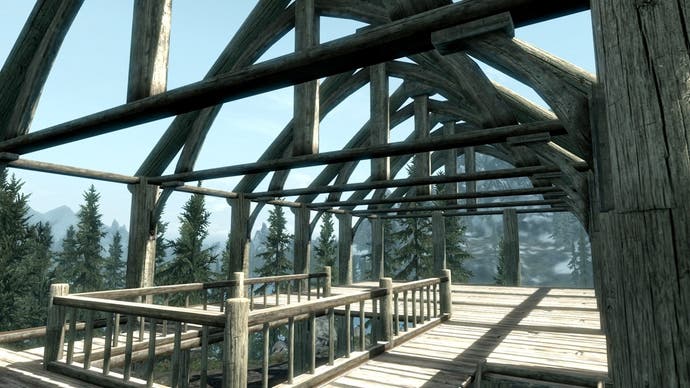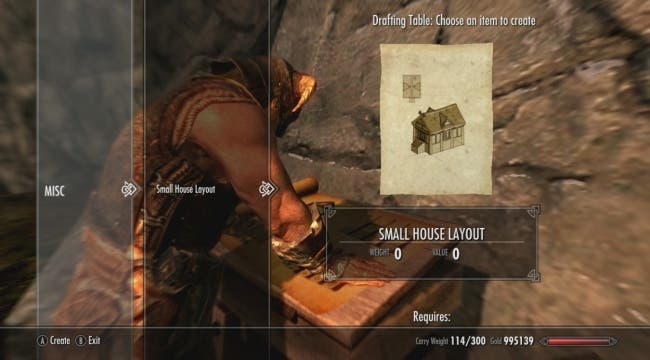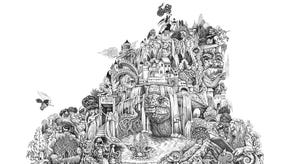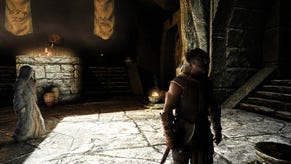Skyrim: Hearthfire Review
Constructive criticism.
What sort of Skyrim player are you? Are you there for the story and the Achievements, taking advantage of the game's loose logic to play multiple characters in one playthrough, heading up the Mage's College even as you take charge of the Thieves Guild, and saving the world while playing as an evil assassin? Or do you use Tamriel's vast canvas as a backdrop for your own adventure, setting your own limits and rules and immersing yourself in its rich milieu?
If it's the first then you've probably got no interest in Hearthfire, the new DLC that lets you build houses. There are no quests here, with no story and no definable ending. You may have already posted a witty comment about Skyrim Sims. Congratulations. Hearthfire is not for you.
If, on the other hand, you've already started planning which of your weapons you want to display where, whether to store gems in the same chest as jewellery, and are actually looking forward to spending hours trying to wrangle floating items into display cases so they're positioned just right, then Hearthfire is most definitely for you. It's just not that good.
OK, that's unfair. There are benefits to Hearthfire and serious role players will no doubt appreciate the improvement your hand-crafted homes offer over the default houses already available for purchase in the towns and cities. It's just executed in a slightly fudged way that only ever makes it a partial success.

Things kick off when a courier delivers a letter inviting you to purchase one of three plots of land in Hjaalmarch, Falkreath or The Pale. Visit the town in question, hand over 5000 gold to the Jarl's steward and you're ready to make like a dragon-shouting Sarah Beeny. A basic and humble small house is the first thing you can build, making plans at a drafting table conveniently located on the site, then constructing it with lumber and nails (crafted from iron ingots) at the new carpentry table.
You create each chunk of your home at the table and they appear instantly and fully formed behind you. Even though you have to build foundations, then walls then roof struts and so on, there's no real sense that it's taking form piece by piece. You can just load up on the required materials, speed through the menus and turn round and find a mansion has appeared.
Start upgrading and your initial small house can become the entrance to a main hall. This hall can then have three wings added to it, with each wing able to accommodate one of three room types. You can add domestic options like bedrooms and a kitchen, or rooms that favour the adventurer, such as an armoury or storage room. If you dabble in the arcane, you can add alchemy or enchanting rooms, or a library.
"Don't expect much in the way of options though. While Hearthfire lets you customise your new home to a certain extent, you're forced to work within very strict parameters."
Don't expect much in the way of options though. While Hearthfire lets you customise your new home to a certain extent, you're forced to work within very strict parameters. The greenhouse can only ever be built on the west side of your house. Kitchens must occupy the east wing. It's easy to see why this has been done - it's clearly a bad idea for Bethesda to start loading too many radical changes on top of a game engine that already falls apart if a mouse farts near your save file - but it does mean that you can't, for example, build three armouries if weapons are your thing.
Despite the various architectural styles in the game, you have no control over the look of your dream house either, nor can you give it a name of your own. You can't opt to build something in the Orcish or Dwarven styles and if you were hoping to settle down in Dunshouting, tough. It's called Lakeview Manor, even before there's a manor there.
Once the structure is built, you do start to get more options. You can add a garden, a pen for livestock, even an apiary for bee-keeping outside. Inside, you can deck out the cellar with a smelting furnace and an all-in-one shrine (provided you've got the right amulets) so you can pick and choose your blessings over breakfast.
And, of course, you can decorate and show off your loot. This is what most players will be wanting to do, and I don't mind admitting that I've already spent more time than is healthy sorting through my groaning inventory chests, picking out the best stuff to display on mannequins and weapon racks. You can even turn your animal pelts into trophies, much like Battlehorn Castle in Oblivion allowed you to do. Who wouldn't want a stuffed hagraven as an ornament?
Even here, though, you're painfully limited. Each wing you build comes with its own workshop table where you can churn out furniture, storage and other items, but you get no preview of what they'll look like or any control over where they'll go. If you choose to build a shelf, it only appears in the designated spot for that shelf. It's all very functional, but means there's absolutely no way of personalising this house that you've supposedly built from scratch.
Build everything on offer and your armoury will be no different to everyone elses. Making this constrictive system all the more annoying, there doesn't seem to be any way to get rid of an item if you don't like it or find its default position annoying. You're assembling a pre-configured kit, basically, and there's no turning back.
There's not even much challenge in maxing out your new pad, as Bethesda's helping hands creep in. Each plot of land comes with infinite resources for mining clay, rock and iron ore within a few feet of your crafting area, while things like straw, glass and lumber can be purchased in bulk from every general store. Despite the obvious comparisons, this certainly isn't Minecraft, where the building is the gameplay. Hearthfire wants you to get the building stuff out of the way as quickly as possible, to the extent that you can designate your follower as your house steward and simply get them to buy in resources and even decorate the whole place.
What else does Hearthfire offer? Several smaller conveniences. 500 gold gets you a carriage that waits outside your door and will take you wherever you want to go. You don't actually get to take a carriage ride through the world though, as you simply appear at the chosen location. Utterly redundant in a game with fast travel as standard, but a nice enough touch if you fancy lording it up as a member of the landed gentry.
You can also adopt a child, but it's never entirely clear why. Unlike Fable, where producing offspring is an organic and random thing and the characters can express a range of reactions and emotions, here you're simply picking one of a handful of pre-rendered moppets who will go through a series of pre-rendered routines.

Bizarrely, right now the game doesn't seem to let your new family live in the new house you've built - even though children's furniture can be added. Instead you have to convert a room in one of the pre-existing homes to a child's bedroom, and only then are you allowed to adopt. Your spouse and child automatically move into this house and, from what I could find, end up stuck there permanently. The option to relocate to your hand-made home vanishes from the dialogue options, leaving the two aspects of Hearthfire strangely divorced from each other.
What can you do with your child? You can play crude games of tag or hide and seek. You can tell them to play outside, or ask them to do their chores. Not chores that help out in any gameplay sense, it's just another animation loop that your child-shaped automaton will go through at your request.
At 400 Microsoft Points, Hearthfire costs about as much as it's worth, and it's definitely a more interesting way of incorporating useful features into the world than simply having you unlock a pre-built house. The difference, ultimately, is fairly negligible and even the most devoted player will be able to see dozens of ways in which the process could have been made more creative and less restrictive. While building has been simplified, too many of the secondary features are awkwardly implemented and poorly explained, leaving you to wonder if you've missed some important cue or if the game has just burped up another bug.
Whether you do it yourself or take the short cuts, once the job is done you'll have a house that is far superior to any of the others in the game, and everything you could possibly need will be in one handy location. For the deep role-player, it's an undeniable boon in terms of pure function. You just won't feel any ownership of the places you build, or be able to stamp your identity on your new virtual home, leaving it feeling like a shallow and perfunctory process. Despite the rugged, rough-hewn aesthetic of Skyrim, Hearthfire ultimately offers all the character and personality of an Ikea cupboard.









